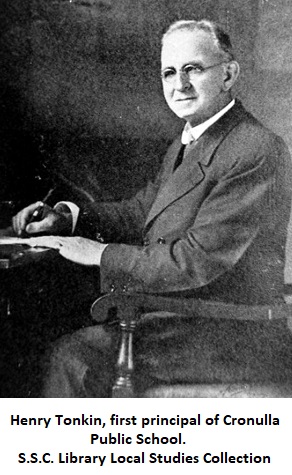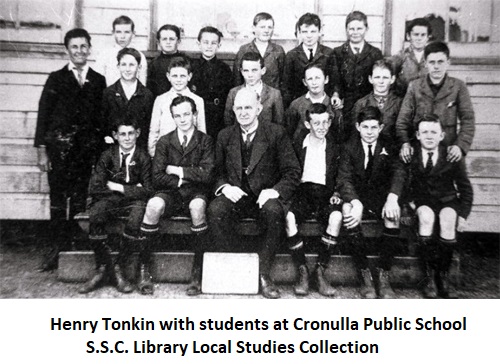

| Welcome | Database | Indexes | Copyright/Disclaimer | Login |

Headmaster,
Educational Innovator
Henry Tonkin was born on 15 February 1859, in
Creswick, Victoria, the son of Jacob Morrish Tonkin (1824-1889) and Margaret
Knowles (1835-1895). Jacob was born in 1824 at St. Agnes in Cornwall, the son of
Jacob Tonkin and his wife Jane, nee Morrish. He came to Australia in 1853 and
by1858 he was living with Margaret Knowles at Ballarat, Victoria.
Margaret was born in 1835 in Kinsale, Co. Cork, Ireland,
the daughter of John Knowles and Mary Tracey. They had two sons - Henry (1859 -
1947) and John William (1862). Jacob and Margaret lived in Eaglehawk, near
Bendigo, Victoria where Jacob was a miner and storekeeper. He was choirmaster at
the Upper California Gully Methodist Church and Director and Manager of the
Unity Company. Jacob Tonkin died on 13 April 1889 at Eaglehawk and was buried in
Eaglehawk Cemetery beside his sister Elizabeth. His obituary in the Bendigo
Advertiser on 24 April 1889, mentioned his sister, Miss E Tonkin and his sons,
John William and Henry ‘of Hillgrove NSW’.
Details of Henry Tonkin’s education are not
known but he appears in the NSW Public Service Lists 1858-1960, where his first
appointment is recorded as 1 May 1883. In the NSW Teachers’ Rolls 1869-1908, his
progress is recorded in hand written entries from 1884 to 1898. He was obviously
ambitious and in January 1884 was promoted to Class lll B, in 1886 to Class lll
A, in 1888 to Class ll B and in August 1898 to Class ll A.
Schools at which he taught
between 1883 and 1888 are not known, but in May 1888 he was appointed
temporarily ‘in charge’
of Swamp Creek School. In October 1888 he was notified of his appointment to
Hillgrove School.
On 24
December 1888, at Nemingha House, Tamworth, NSW, Henry Tonkin married Edith
Millicent Paul.
Edith was born in Tamworth in 1867, the daughter of Joseph Paul
and his wife Millicent. They had five children all born at Hillgrove:
Millicent Beatrice born 1893, died1963, married Leonard Fitzgerald in 1923
Morrish Paul born 1894, died 1971, married Rene Adelaide Denny at Coffs
Harbour in 1938.
Joseph William Edmond born 1900, died1989, married Gladys Edith Meacle at
Paddington in 1938.
John
Henry born 1902, died 1987, married Margaret Enid Smith in 1936.
Josephine Edith Elizabeth born 1909, died1966, married Athol J Sutherland at
Hunters Hill in 1928.
The town of
Hillgrove, 30 km east of Armidale, in the New England district of New South
Wales, was established in 1884 and grew rapidly during the 1880s and 1890s due
to antimony and gold mining. At its peak in about 1898 the town had a population
of about three thousand, similar to Armidale. It was a thriving community and in
1895 became the first town in Australia to be supplied with power by means of
hydro-electricity which operated from Gara Gorge to the west. Since mining
closed down in 1921 many of the buildings were sold and transported to other
towns in the district. Hillgrove became a near ghost town with a population of
less than one hundred. The only two original buildings now are the post office
and the school which has become a museum with a collection of photographs and
memorabilia giving an insight into everyday life in old Hillgrove.
Henry Tonkin
remained at Hillgrove as ‘teacher in charge’ until he moved to Cronulla in1910,
to take charge of the recently established Cronulla Public School. Under the
leadership of Tonkin, described as ‘a capable, painstaking, energetic man ….and most enthusiastic in
his work’, Hillgrove school became known as the most
progressive, demonstration school in the NSW education system. Certain subjects,
were taught to university level and enhanced by practical work done in the
surrounding area. Tonkin had amassed a collection of minerals, fossils,
vegetable products and manufactured artifacts, which he used in object lessons
to teach the boys minerology and geology. Music, art, literature and other
subjects were not neglected. The school also had a museum of various related
articles and an extensive circulating library. Henry Tonkin’s goal was to make
education practical and to encourage the people of the town to show an interest
in the school and its work. He encouraged visitors, including tourists to the
New England district, to come to the school to view the beautiful established
gardens, the museum, gymnasium, herbarium and the many fantastic photographs he
had taken of the surrounding area and then turned into lantern slides for his
school work. The gardens were cared for by the students, each class having a
section, and providing an area for nature lessons and practical instruction in
agriculture. The school also had a rifle range, a cooking school, photographic
department and a fife band. For many years the physical drill shield of the
Armidale district was held. Funding for these projects came from exhibitions of
school work, public entertainments and Tonkin’s private purse.
In June
1908, a public meeting was held in Cronulla Hall following the recent refusal of
the Minister of Public Instruction to erect a public school at Cronulla. It
called on the local residents to agitate until a school of a fairly high grade,
presided over by a competent teacher, as the class of school required, had been
approved. Cronulla had progressed in every way and there was the necessity for a
public school. Over seventy pupils of residents were eligible to attend and
probably a large number of children of visitors would also attend.
In 1910 Cronulla finally gained a local
public school despite reluctance from the Minister J A Hogue and opposition from
Edward Thacker, President of the Miranda Central School Board, who warned that
Cronulla could expect to get only a ‘’low class school’. Cronulla was unusually
fortunate in attracting
the outstanding teacher, Henry Tonkin, who had been advised to move to the coast
for his health. The school was situated on land that is now Monro Park, opposite
the railway station.

The school
opened with an enrolment between seventy and eighty but, as the district
developed rapidly it was soon realised that the building would not be big enough
and that more land was required. The Lands Department refused a request for two
adjoining lots stating
’it was unnecessary for the children to have much playground when the beach was
so handy for them to play on’. These two lots were finally
acquired two years after the school was established. In 1919, Henry Tonkin was
still agitating for additional classrooms. In 1922, the present site of Cronulla
Public School, fronting Gunnamatta Bay, was purchased for £4,000 but it would be
three years before the building could be occupied. The new school was a two
storey building, containing eight classrooms to accommodate three hundred and
sixty four pupils, large assembly halls on each floor, headmaster’s rooms, staff
room, four bathrooms, vestibules, storerooms and staircases. It was finally
opened by the Minister for Education (Mr. Mutch) at the end of January 1926 and
after Henry Tonkin had retired in 1924.
Henry Tonkin
involved himself in the local community as well as educating the local children.
He was choirmaster for the Cronulla Methodist Church, Secretary and Librarian of
the Cronulla School of Arts for thirty seven years, a member of the Masonic
craft for many years, founder of the Cronulla Masonic Lodge and three times
Master of his Lodge. He was Secretary of the Cronulla Theatre, Captain of the
Cronulla Rifle Club, a life member of Cronulla Surf Life Saving Club and active
in the Boy Scouts.
Henry Tonkin
died on 10 August, 1947 at Cronulla. He was survived by his wife Edith, his
children Millicent, Paul, Edmund, John and Josephine and seven grandchildren. He
was cremated at Woronora Cemetery. Edith Tonkin died in 1952 and was also
cremated at Woronora Cemetery. Henry’s name is remembered by Tonkin Street in
Cronulla and the reclaimed area at the head of Gunnamatta Bay now known as ‘The
Henry Tonkin Memorial Park’.
Two
remarkable tributes, by former students, attest to the influence and legacy of
Henry Tonkin. The first, on the occasion of his retirement in 1924, was by Karl
S White published in the
Armidale Chronicle on Saturday, 2 April 1924. He reflected
how former students ‘look
back with gratitude….recognising that his sole object was their advancement and
his reward satisfaction in fitting them for the stern battle with life’.
In the Manning River Times on Wednesday, 3
September 1947, M.M.H., a former student, described him as a
’great educationalist who had a
remarkable influence upon the children who came under his care… one of the big
men of the teaching service…(with) his lofty educationalist outlook and untiring
efforts to give the best to his students’.
By Colleen Passfield 2018
Click on
the heading on the name
TONKIN, Henry (1859-1947)
to view the entry for Henry
Tonkin and his family in the database.
References:
Victorian BDM
Sutherland Shire-a history to 1939- Maryanne Larkin
Aussie Towns
New England Tourism
Trove
Australian Town and Country Journal
Armidale Chronicle
Manning River Times